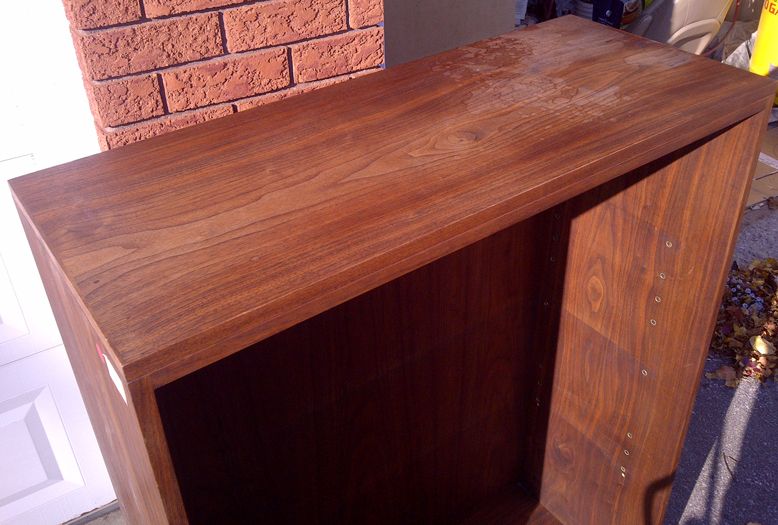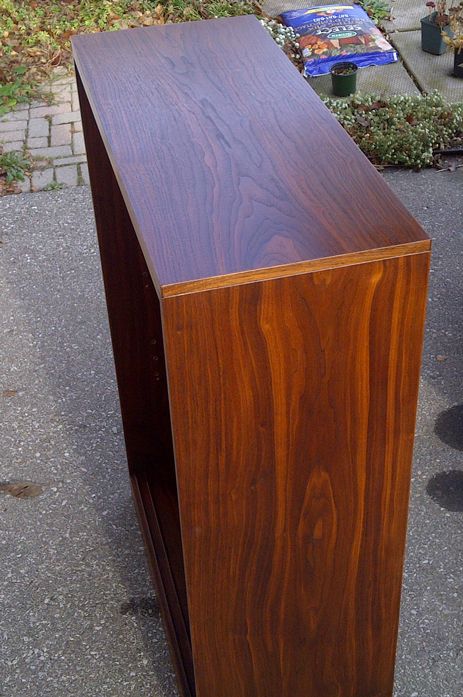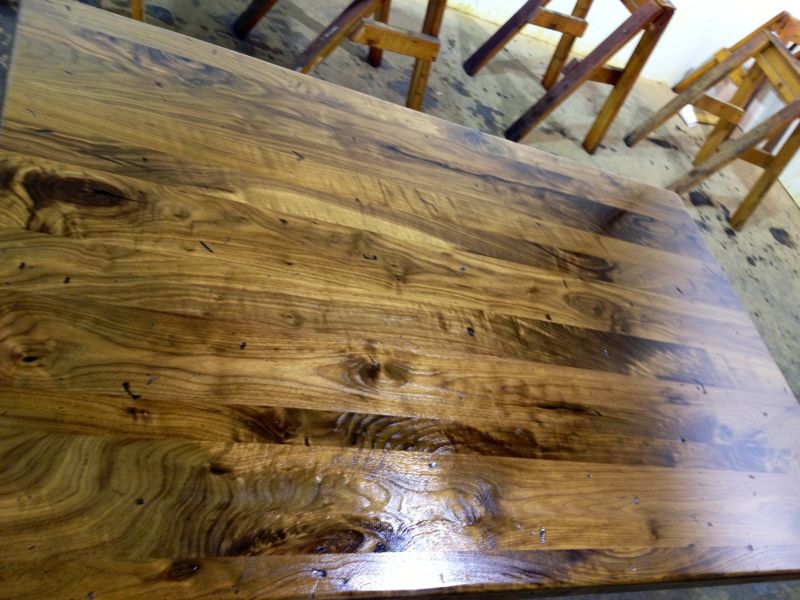Finishing Oils
Here are some opinions and some learning resources for a finisher trying to choose a natural oil finish. July 18, 2013
Question
Any tips on using oil finishes? Normally I am a lacquer guy. I have a client that wants to put an oil on a walnut table.
He didn't know what he wanted so I got a bunch of them:
Watco Teak Oil
Watco Danish Oil
Wood River 100% Tung Oil
Boiled Linseed Oil
So far I made some walnut test pcs about 6 x 10". I used two pieces for each oil, as I plan on showing them to him oil only and oil with a lacquer topcoat. I followed the instructions on the container.
Teak and Danish oil was apply heavy, let soak for 1/2 hour, making sure it didn't have any dry spots. Soak it again for 15 minutes and wipe dry.
Tung oil was thinned 50% with VM&P Naphtha and put on heavy, let soak for 15 minutes and wipe dry. Going to let dry overnight and repeat 2 more times without thinning.
BLO was thinned 50% with VM&P Naphtha and wiped on heavy let soak for 15 minutes and wiped dry.
So what's next? Do I just wait for it to dry a few days before I apply a finish coat? Or do I reapply the oils a few more times? Am I buffing the oil? I don't plan on any wax on any of them.
Forum Responses
(Finishing Forum)
From contributor D:
With tung oil, try letting the piece dry a day or so, sand like sanding sealer, and recoat. Several sandings and coats can look and feel like a sprayed-on film finish.
From contributor R:
Watco products are often mixtures of oil, solvent and varnish, or oil solvent. On boats that aren't varnished, we use tung oil over BLO, as tung has much better resistance to water. As suggested, several coats applied over several weeks is recommended. Anything Watco makes can be duplicated more cheaply than buying theirs.
Tung oil requires reapplication every six months or so, as needed. If one lets the finish dry out or open up, it requires starting over with the process. BLO is not in the same ballpark as TO.
From contributor C:
Good advice from the other posts. Only thing I will add is, do not even let your client see the boiled linseed! Beyond smelling nice, it won't meet your expectations, much less your client's. Boiled linseed oil is actually raw linseed oil that has had metallic driers mixed with it to encourage drying. Problem is it never really dries hard like some of the other options you've mentioned, and it will darken the wood greatly with time. It is also probably the least durable finish of your choices, followed closely by the tung oil.
I have never sprayed lacquer over tung or boiled linseed, so I can't say for certain, but I would be hesitant with the BLO due to the drying issue. Maybe someone else has experience on that.
From contributor R:
I would recommend Waterlox. It's easy to apply and needs no topcoat. It is tung oil based. Build several coats and rub out the final with 0000 steel wool. You can thin with turpentine. I pad on thin coats like shellac and do not wipe off excess (there is none).
From contributor M:
Wet sand that first coat or two into the wood using black wet or dry paper. Use 400 grit the first time and 600 the second. I use a pneumatic jitterbug type sander or a DA. Usually just 2 coats using this method is really nice. If you want more build after the first 2 sanded coats, just wipe on and wipe off, allowing 24 hours drying time between coats. For a high gloss look, buffed out paste wax looks really nice but is usually not required.
From Paul Snyder, forum technical advisor:
Start with Bob Flexner's article ' Oil Finishes: Their History and Use' at Popular Mechanics. It describes the types of oil finishes including drying oils, varnishes, and oil/varnish blends.
From contributor A:
I will advise you to apply Waterlox. It is effortless to be used.
From contributor I:
I would not use Waterlox. Not only is it challenging to apply, the dry/cure times will kick you in the butt! You would be better off spraying the table with lacquer. Your client also wanted an oil finish, and Waterlox will form a film, unless you thin it, and at that point you are basically making Danish oil.
There are people who post videos to the internet and make it appear as if Waterlox is easy to apply with a foam brush, but you'll get results that are about on the level of what you would expect from a painting contractor. I tried spraying it once, and that did not work too well.
I am a big fan of Watco Danish Oil. It is simple, foolproof, and readily available. There is no way you can possibly screw up provided you wipe the excess thoroughly.
I generally sand the wood to 320 or 400 grit to burnish the surface, soak the wood for a while, wipe thoroughly with painter's rags. Keep an eye on the surface for at least 4-5 hours and wipe as needed, since oil may continue to bleed. Sometimes I will wet sand on the first or second coat with oil.
Allow at least 24 hours of dry time and repeat until you are satisfied. In some cases I will apply paste wax and buff after about a week, however I would skip the wax on a coffee table that is going to see use.
I built a white oak coffee table and finished with Danish oil and it has done really well over the last 5 years. I actually use it, and it does see some wear and tear. The dead flat sheen does not show scratches. I even had a container of some kind of lemon gelato leak and melt all over it. This mess sat overnight, and it did not do any harm, which surprised me as it seemed somewhat acidic. At some point, I will renew the finish by simply wiping on another coat with a painter's rag.
Now before the post cat and conversion finish aficionados call BS, I am not saying an oil finish is always appropriate, and unless it is desirable for whatever reason, I spray lacquer or CV.
From the original questioner:
I am tending towards the teak oil at this point. I have been applying thin coats of all the oils and letting them dry, and using 500 grit, doing a light scuff sand and applying another thin coat. The tung oil dries a lot slower and I am waiting until it dries to the touch, which seems about 2 days in my drying room (70ºF). Then I do the same thing, 500 grit and another light coat. I can see the tung oil is starting to develop a very thin film, while the others are developing a slight sheen.
From contributor P:
I recently refinished a walnut veneer bookcase with polymerized tung oil. It came out fantastic. The piece had obviously been oiled previously, so I figured using oil again would avoid fisheyes, etc. Below are before and after pics. Bookcase is 15" wide.
Several years ago, I used BLO to pop grain on some gumwood doors (after stripping off layers of paint). Waited a couple days, then sprayed a couple light coats of Target shellac and then their hybrid varnish (now EM2000) and I had a very happy client.

Click here for higher quality, full size image

Click here for higher quality, full size image
From contributor L:
I'd have to disagree with contributor I's comments about Waterlox. I've been using it for years and it's actually not that difficult to apply, though admittedly a little more difficult than lacquer. Walnut is a perfect wood for it as well. Follow these directions and you'll get a great looking finish that enhances the depth of the walnut grain.
Sand to 320 grit and rub the raw wood with some 00 steel wool. You'll close the pores a little with the steel wool, so thin the first coat of Waterlox Original Sealer with about 25% mineral spirits for good penetration. Apply it with a rag, rubbing it into the surface initially then re-wet the rag and top it off with a fairly heavy coat. Most of that will absorb into the wood after several minutes, but don't worry about wiping the excess off.
Put a fan on it and check it after a few hours. If it's no longer tacky, apply another fairly heavy non-thinned coat (a little lighter on any vertical surfaces to avoid running) with a rag without sanding in between. The second coat should be fairly uniform but doesn't have to be perfect, as the Waterlox Sealer will self-level. The second coat should cure overnight.
Next day, denib with 320 and rub with 000 steel wool. Clean and apply a another coat, thinned with 10% mineral spirits. Use a fan and check after a few hours. If no longer tacky, apply a full strength coat without sanding in between. Leave overnight.
The next day you may find the build is thick enough, but if not, repeat day two again until you're satisfied with it.
Once the build is where you want it, the Waterlox will have a glossy sheen. This will deaden slightly after 30 days or so. If the sheen is too high, let the last coat cure for at least 24 hours (48 would be better), wet some 0000 steel wool with mineral spirits and rub the entire surface with medium pressure to give a duller satin sheen.
It may take a little practice but your customer will love the deep, rich grain of the walnut. If there's any figuring or burl in the wood, it will definitely pop beautifully.

Click here for higher quality, full size image
AI enhanced answer (added Jan 14, 2025):When choosing a natural oil finish for woodworking, consider these key points:
1.
Type of Wood: Different woods react differently to oils. For example, dense woods like maple might benefit from a penetrating oil like tung oil, while softer woods like pine might do well with linseed oil.
2.
Desired Finish: If you want a high sheen, consider oils like Danish oil which can be buffed to a shine. For a more matte, natural look, raw linseed or walnut oil might be better.
3.
Durability: Tung oil and polymerized oils offer good durability and water resistance. If the piece will see heavy use, these might be your best bet.
4.
Safety and Health: Look for food-safe options if the wood will contact food. Pure tung oil or flaxseed oil are good choices here.
5.
Application and Maintenance: Some oils require multiple coats and frequent reapplication. Consider how much time you're willing to invest in maintenance.
6.
Environmental Impact: Natural oils are generally more eco-friendly than synthetic finishes. However, check for VOC content if that's a concern.
7.
Color Enhancement: Oils can enhance the wood's natural color. Walnut oil, for instance, can darken wood slightly, adding warmth.
Choose an oil that aligns with your project's needs in terms of appearance, durability, and maintenance. Always test on a scrap piece first to see how the oil interacts with your specific wood.


